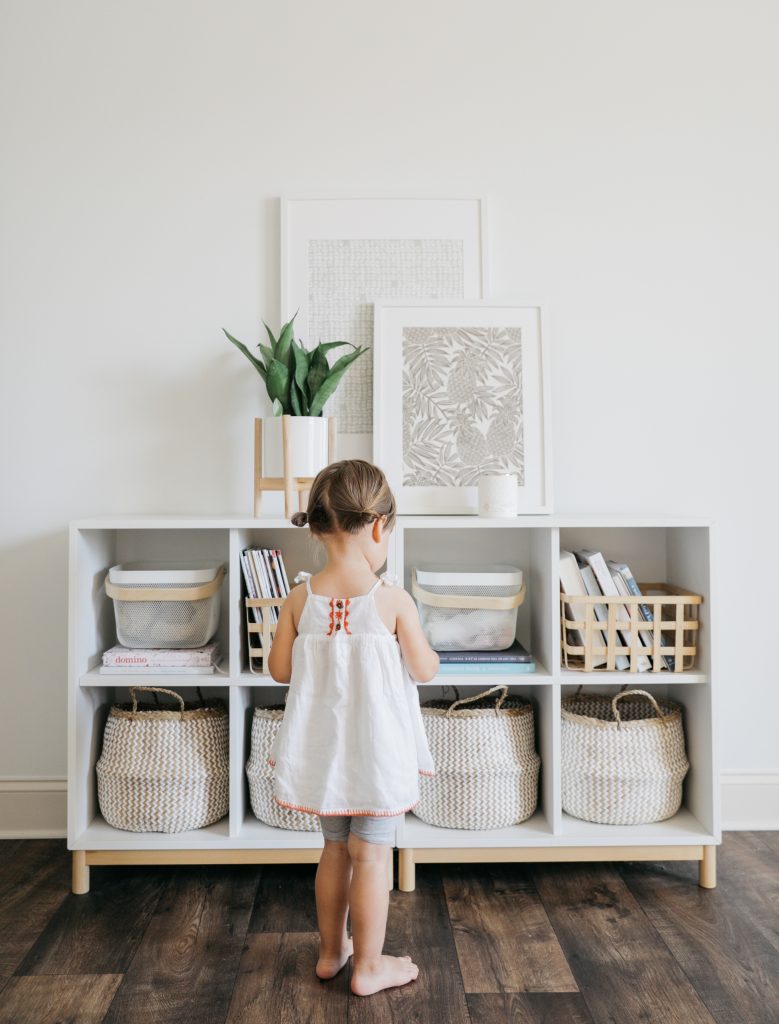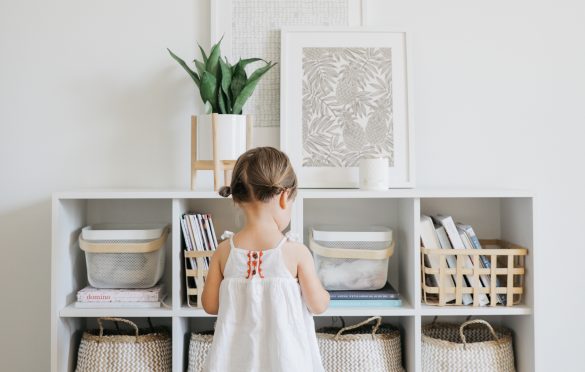
image credit: Annaka Davidson
Have you ever had a playdate go like this: children begin to play and immediately doctors kits are dumped out on the couch, toy bins turned over, play food strewn about the living room floor? The once-tidy home quickly losing it’s put-together feel?
Do you sometimes find yourself wishing your kids had fewer toys but you don’t know how to start minimizing?
Six months ago, I was this mama. I’d walk through our home, head spinning from dodging yet another toy pile that now needed to be picked up—and had barely been played with.
While this is certainly a first-world issue, too many toys in the home is a real source of stress for parents and children in our culture. This phenomenon of toy accumulation began in 1955 and is still going strong today. In fact, the United States now contains about 3% of the world’s children but 40% of the world’s toys.
Research from sociologist Juliet Schor’s book Born to Buy, found that the average American child receives seventy new toys a year.
I’d walk through our home, head spinning from dodging yet another toy pile that now needed to be picked up—and had barely been played with.
The majority of our culture has accepted these facts. But for our family, I couldn’t help but observe that living with so many toys in the home just wasn’t working. When I found myself picking up after my kids more than playing with them, I knew something had to change.
I first decided to minimize our toy collection for my own sake, but I had reservations. I worried that I would be depriving our girls of an important part of childhood by not having all their toys out at once. I wondered if they would act out in anger or would meltdown when a missing toy was needed. Would I be harming them more than helping them by minimizing toys?
I turned to Kim John Payne’s book Simplicity Parenting for support. My toy-minimization fears quickly subsided. The research stating that fewer toys promotes more peaceful, deeper, and meaningful play made sense to me.
I began to think about toys differently. While a mix of toys was an important part of our girls’ world of play, I realized it should not be the overwhelming center. I started to wonder about how the number of toys in our home affected our girls.
Could a more manageable amount of toys facilitate our five year old’s role in caring for her own toys? Did a mountain of toys teach our girls to undervalue them all — always holding out for the next best thing and always wanting “more”? Payne’s research said yes.
I wanted our home environment to encourage an appreciation for what we have and an opportunity for creative, meaningful play. That was enough motivation for me to take toy simplification seriously.
Here’s what I did:
01. I collected all of the toys in the home into one room. It was a staggering amount. The girls were with Grandma and Grandpa for several hours, so I worked quickly.
02. I separated the toys into three piles: beloved toys that were played with daily, toys that served a purpose for imaginary play, and toys were not played with daily.
03. Toys played with daily and toys encouraging imaginary play (think: dress-up clothes) stayed in the home. Toys that were liked but not played with daily went into 16 gallon plastic containers for storage. These plastic containers were placed in the basement for the time being. I didn’t want to donate anything yet, but did want to change the home’s environment significantly and observe.
When I was done sorting, about 10 percent of the toys remained in our home. I organized most of them in my 5 year old’s room, leaving a small number of beloved toys visible.
Dress-up clothes went in one dresser drawer. Dolls went in a small wooden bench. A couple games, balls, and some building toys went to the living room. I placed them in small covered containers to limit visual clutter.
When the girls came home, I held my breath. Our one year old wouldn’t care about the changes, but I had no idea how our five year old would react. I told her that I had organized the toys today and that her room looked different. I said that all her toys were still in the house and if there was one she couldn’t find but wanted, then she could ask me for it.
She peeked into her room, and I’ll never forget her reaction. She looked back at me, beaming, and excitedly said, “Mom! Thank you!” She loved having all the extra space. And I breathed a sigh of relief.
Over the next few months, I continued to observe our home with fewer toys. Creative play increased, the amount of time engaged in play extended, and the girls participated in clean-up more often.

When toys in storage were asked for, I would retrieve them, but we would return other toys to storage so the amount of toys in the home stayed the same. I did this with our five year old’s help and explained to her why it was important to have “just the right amount” of toys in the home.
“Mom! Thank you!” She loved having all the extra space.
After three months, I started donating toys from storage. By then, I had a good feel for what my daughters played with and what they did not.
At first it was hard to let go of some of the toys. I had memories attached to some of them. But I knew they weren’t serving their purpose sitting in our basement. It was time for these toys to move on and hopefully become beloved by another child.
As the months went on, I started to realize what a surprising challenge it was to keep the number at a “just right” amount. Christmas, birthdays, and visits from grandparents all caused an influx of toys in the home. We continued to work with our five year old to move the no-longer-played-with toys to storage when new toys entered her world.

I’ve learned that keeping toys to a minimum in today’s world is an ongoing commitment. My rule of thumb now is that if it takes longer than about five minutes to tidy up toys or if my daughters seem overwhelmed in managing their own toys, then it’s time to declutter again.
I rotate new toys in the home every 2-3 weeks and continue to be amazed at our daughter’s excitement to play with their old toys again.
Minimizing our toys didn’t happen overnight. It’s been a ongoing project and the results have been wonderful for our family. With fewer toys to take care of, we have more time to spend time together as a family. We also spend more time outside on “adventures” and reading together.
I’ve learned that keeping toys to a minimum in today’s world is an ongoing commitment.
My stress level in the home has also noticeably decreased as the amount of toy clutter has decreased. I’ve found myself more excited to sit on the floor and play with my daughters, and I’m more able to focus on them instead of being distracted by the mess being made.
And, I’ve noticed changes in our five-year-old daughter. While she may still ask for a toy if taken into Target and tempted, she’s also told me in stores that we don’t need to buy anything more.
In prayer, I’ve noticed her thanking God for our things and for our adventures, as she’s becoming more grateful for what we do have. She’s discovering new interests too, like a love for art. And she’s started tidying her room a couple times a week on her own, because it’s manageable.
Fewer toys in the home has been a win-win for our family. If you’re considering minimizing toys, I encourage you to go for it. It’s worth a try, and experimenting with less could be a positive experience for your family too.


Where did you get your 8 cube storage shelves? I’ve been searching for something like this to help organize and minimize to toys and they are all cheap particle board. Thanks, great post!!!